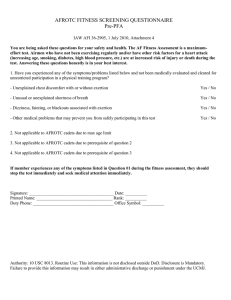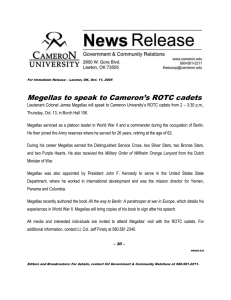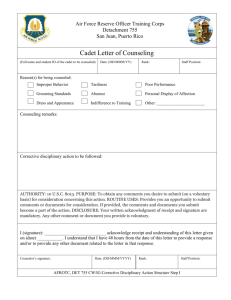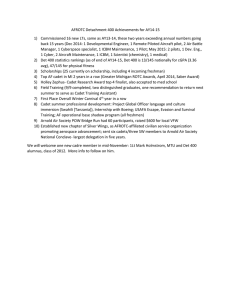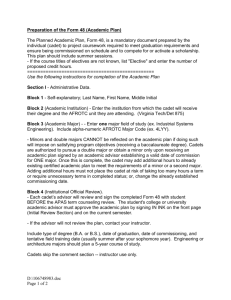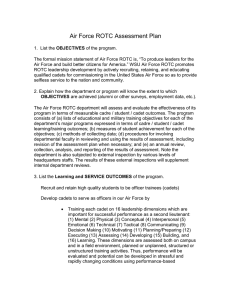Air Force ROTC Assessment Report June 2006 –June 2007
advertisement
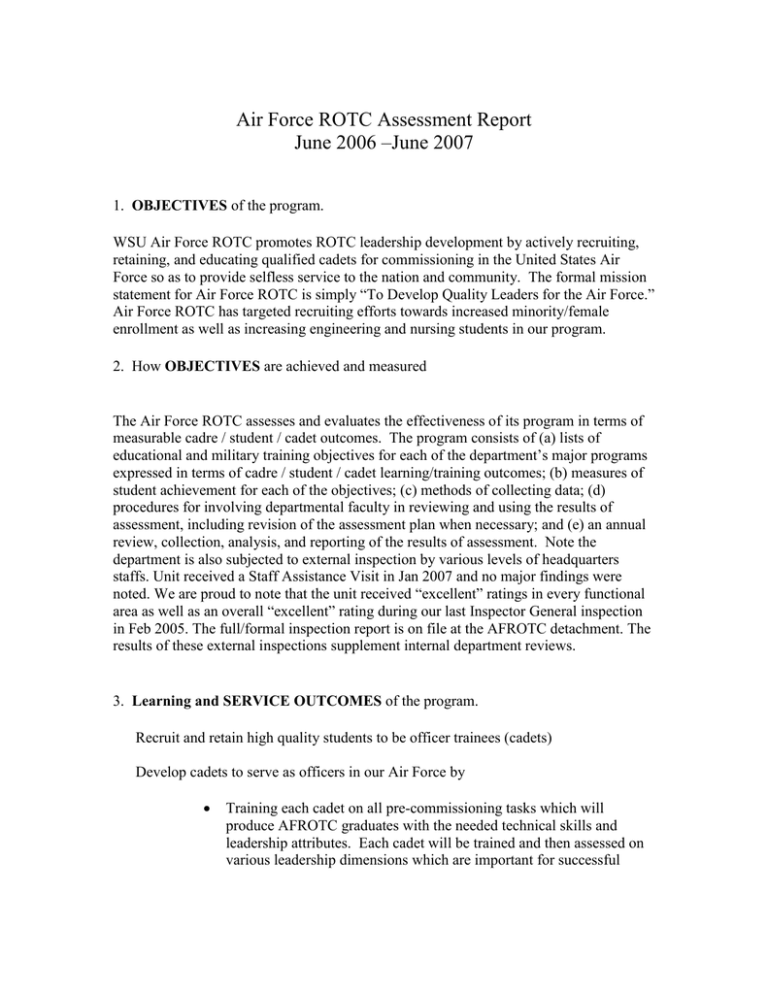
Air Force ROTC Assessment Report June 2006 –June 2007 1. OBJECTIVES of the program. WSU Air Force ROTC promotes ROTC leadership development by actively recruiting, retaining, and educating qualified cadets for commissioning in the United States Air Force so as to provide selfless service to the nation and community. The formal mission statement for Air Force ROTC is simply “To Develop Quality Leaders for the Air Force.” Air Force ROTC has targeted recruiting efforts towards increased minority/female enrollment as well as increasing engineering and nursing students in our program. 2. How OBJECTIVES are achieved and measured The Air Force ROTC assesses and evaluates the effectiveness of its program in terms of measurable cadre / student / cadet outcomes. The program consists of (a) lists of educational and military training objectives for each of the department’s major programs expressed in terms of cadre / student / cadet learning/training outcomes; (b) measures of student achievement for each of the objectives; (c) methods of collecting data; (d) procedures for involving departmental faculty in reviewing and using the results of assessment, including revision of the assessment plan when necessary; and (e) an annual review, collection, analysis, and reporting of the results of assessment. Note the department is also subjected to external inspection by various levels of headquarters staffs. Unit received a Staff Assistance Visit in Jan 2007 and no major findings were noted. We are proud to note that the unit received “excellent” ratings in every functional area as well as an overall “excellent” rating during our last Inspector General inspection in Feb 2005. The full/formal inspection report is on file at the AFROTC detachment. The results of these external inspections supplement internal department reviews. 3. Learning and SERVICE OUTCOMES of the program. Recruit and retain high quality students to be officer trainees (cadets) Develop cadets to serve as officers in our Air Force by Training each cadet on all pre-commissioning tasks which will produce AFROTC graduates with the needed technical skills and leadership attributes. Each cadet will be trained and then assessed on various leadership dimensions which are important for successful performance as a second lieutenant. The various leadership dimensions include: (1) Mental (2) Physical (3) Conceptual (4) Interpersonal (5) Emotional (6) Technical (7) Tactical (8) Communicating (9) Decision Making (10) Motivating (11) Planning/Preparing (12) Executing (13) Assessing (14) Developing (15) Building (16) Learning These dimensions are assessed both on campus and in a field environment, planned or unplanned, structured or unstructured training activities. Thus, performance will be evaluated and potential can be developed in stressful and rapidly changing conditions using performance-based assessments. Cadet performance is documented in individual cadet records. ROTC cadets are motivated to serve our nation. Cadets should understand that the opportunity to serve the United States of America as a commissioned officer in one of the military services is a privilege, not a right. Each cadet must meet the following requirements for commissioning: (1) Complete the General Military Course (GMC) or meet other eligibility requirements for acceptance into the professional course. (2) Be contracted into and complete the Professional Officer Course (POC) to include AFROTC Field Training. (3) Be accepted by the Department of the Air Force for a commission through the accessions process. (4) Complete all requirements for a baccalaureate degree. Commission those qualified cadets not to exceed current Air Force requirements - for AY 06/07, 22 cadets fulfilled all requirements and were commissioned Service all interested and qualified university students from the greater Dayton, Ohio area. Note; although AFROTC Det 643 is hosted at WSU, the cadet wing is populated by cadets from WSU, University of Dayton, Cedarville University, as well as other local universities and colleges. We focus our efforts to increased representation of minorities/females in AFROTC as well as engineering/nursing students. We capitalized on the abundance of experience available through Wright Patterson AFB for use as enhancements to training programs and as mentors. 4. MEASURES used to assess each outcome. HQ AFROTC standards for viable detachments are a 3-year running average of 15 commissioned students per year. Cadet specific performance is documented in each cadet record and includes summer field training performance. Feedback is provided to all cadets and they are reevaluated in all measured areas continuously throughout their time in our program. AFROTC Det 643’s compliance with Air Force Instructions is measured through selfinspection checklists, Staff Assistance Visits, and formal inspections from the Inspector General team. 5. FINDINGS used to assess success of the program. Det 643 has met HQ AFROTC viability standards for AY 06/07 and expects to maintain this standard for the foreseeable future. Enrollment statistics for the upper classes vary according to Air Force requirements for the graduation year. Officer production in AY 03/04 was 27 officers, AY 04/05 saw a decrease to 11 officers due to Air Force requirements, and AY 05/06 increased slightly to 14 officers. We commissioned 22 officers in AY 06/07 and anticipate commissioning 14 officers in AY 07/08. The 22 cadets who were commissioned in AY 06/07 represented 28% of the original 78 cadets who were originally members of this graduating class. All new commissioned officers from Det 643 met or exceeded the 16 leadership dimensions upon which our training is focused. AFROTC Det 643’s conducted two self-inspections during this calendar year with no findings and 100% compliance with Air Force Instructions. Det 643 capitalized on the strength of a diverse cadre in AY 06/07, 5 of 6 military members are minority or female. We intensified recruiting efforts to target minority and female students. We’ve had significant success in this area as females composed 35% of our returning freshman class from AY 06/07. Our inbound freshman class of 75 students for AY 07/08 consists of over 35% female and 30% minority students. Our success in attracting engineering/nursing students is reflected in the 50% engineering student representation in our returning freshman class and 300% increase in contracted nursing cadets. 6. SUGGESTED IMPROVEMENT AREA Det 643 should continue to maintain the course on increasing minority/female recruitment to match WSU demographics during AY 07/08. Det 643 continues to have a diverse cadre where 4 of 7 military members are minority or female. We will aggressively target students attending Wilberforce and Central State University with the AFROTC Historical Black College and University (HBCU) scholarship.
